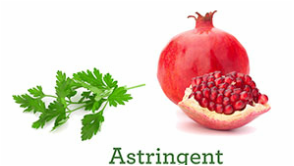
Astringent taste is dry, cooling, and heavy by nature. It can be found in legumes (such as beans and lentils), raw fruits (including cranberries, pomegranates, pears, and dried fruit), vegetables (such as, broccoli, cauliflower, artichoke, asparagus and turnip), grains (such as rye, buckwheat, and quinoa), spices and herbs (including turmeric and marjoram), coffee, and tea. Lighter astringent taste can be found in popcorn. Distilled vinegar, very cold water, and rubbing alcohol also add to astringent flavors.
Tannins are what cause red wine’s dry and astringent taste, which is particularly noticeable on the front and center part of the tongue. Astringent taste is not as cold as Bitter taste but has a greater cooling effect on the body than Sweet taste. Astringent taste is classified more in relation to its effect on the tongue than its actual taste. It creates a puckering sensation in the mouth (such as cranberries) or a dry, chalky feeling (such as many beans). Foods like broccoli or cauliflower have a mildly Astringent taste that is less detectable. Dry foods such as crackers and chips, most raw vegetables, and the skins of fruits also have Astringent qualities.
